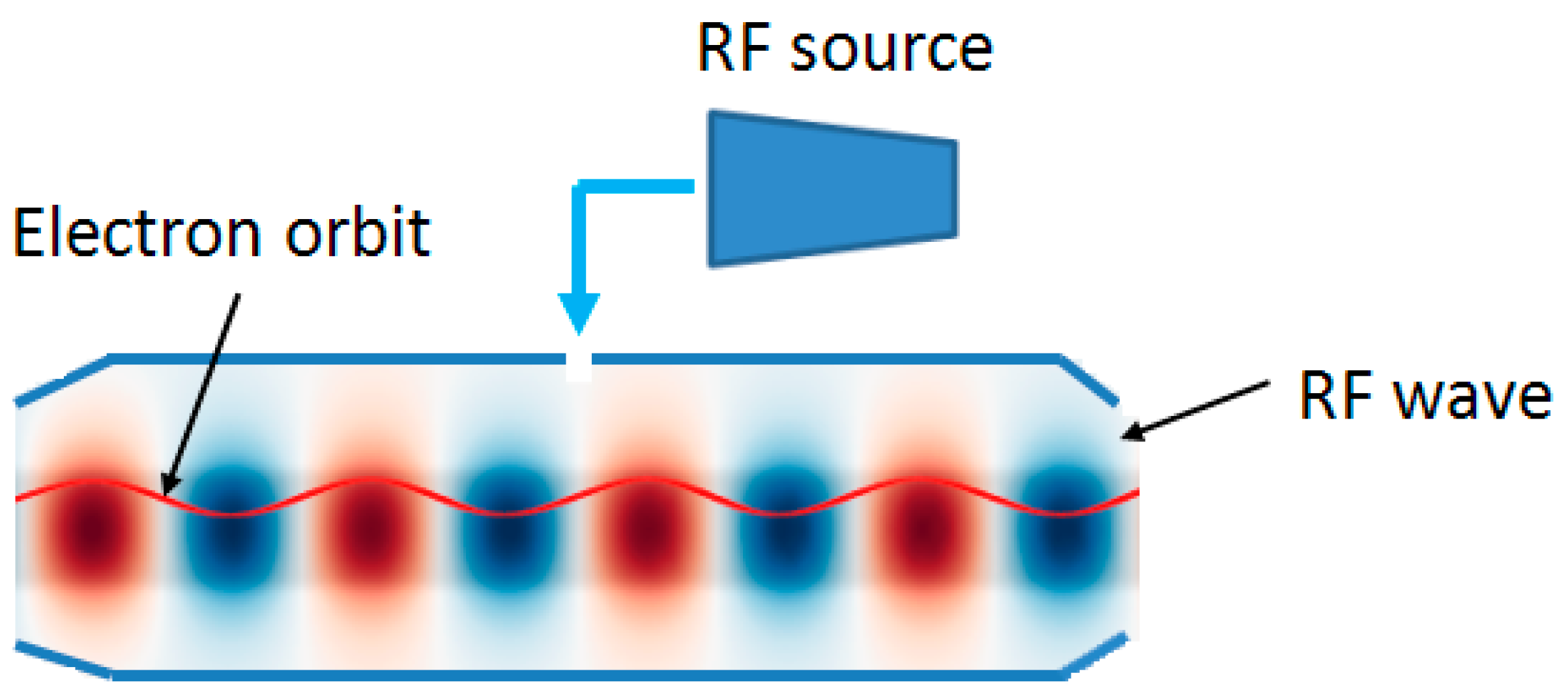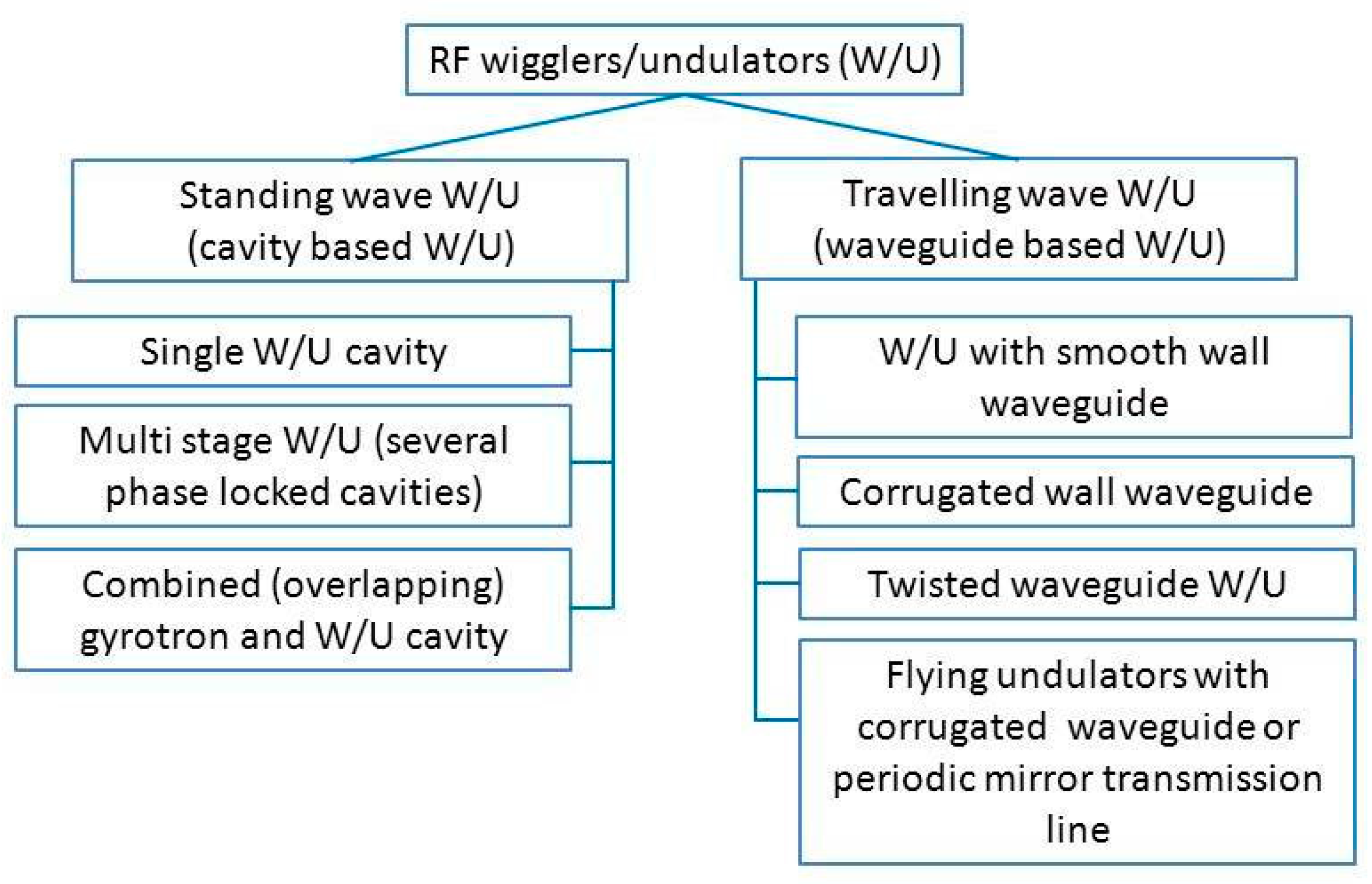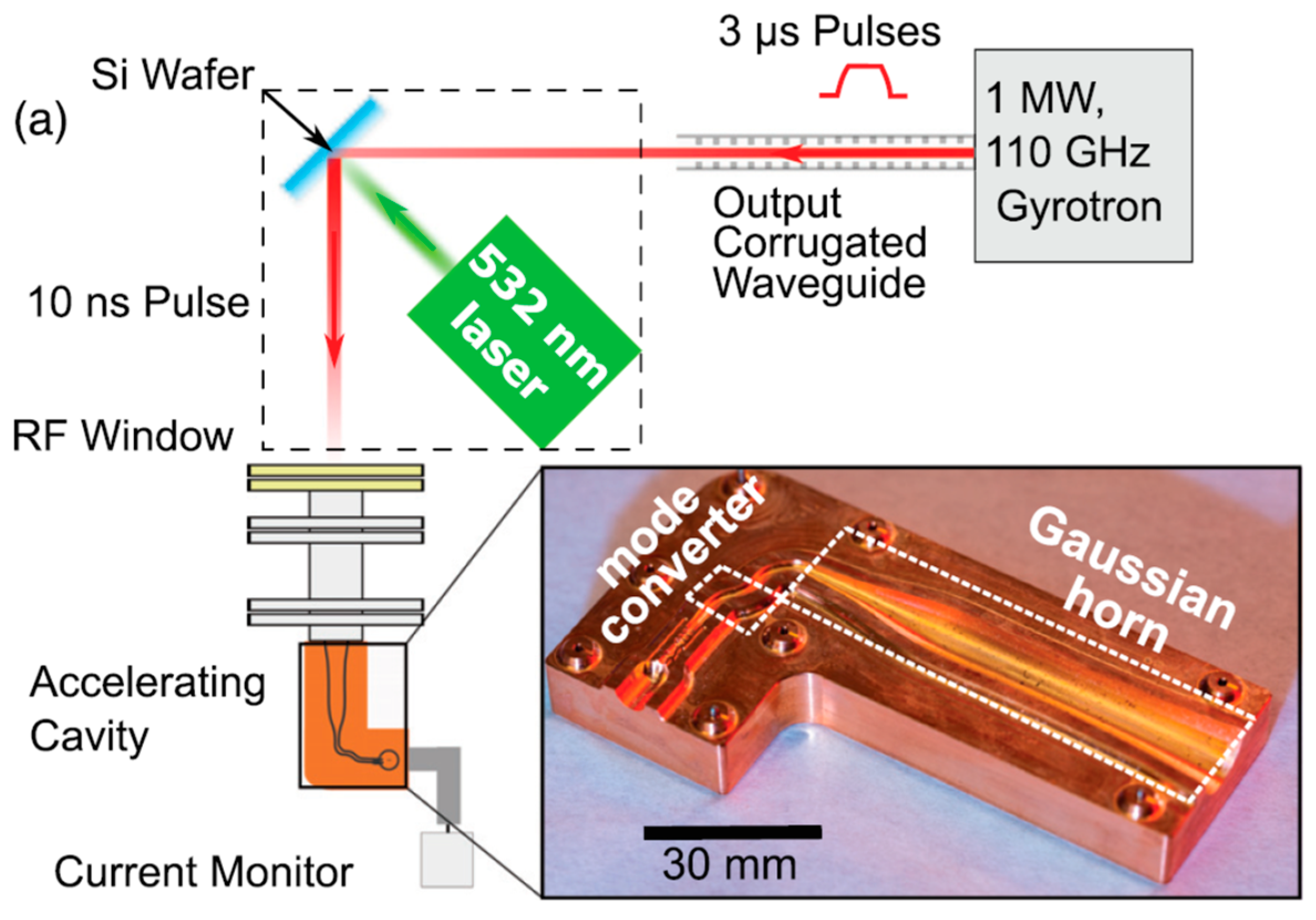Gyrotrons as High-Frequency Drivers for Undulators and High-Gradient Accelerators
Abstract
:1. Introduction
2. Microwave Wigglers and Undulators
3. Gyrotron-Powered Microwave Wigglers and Undulators
4. Gyrotron-Driven Ultra-Compact Particle Accelerators
5. Conclusions and Outlook
Author Contributions
Funding
Informed Consent Statement
Data Availability Statement
Conflicts of Interest
References
- Thumm, M. State-of-the-Art of High-Power Gyro-Devices and Free Electron Masers. J. Infrared Millim. Terahertz Waves 2020, 41, 1–140. [Google Scholar] [CrossRef] [Green Version]
- Benford, J.; Swegle, J.A.; Schamiloglu, E. High Power Microwaves, 2nd ed.; CRC Press: Boca Raton, FL, USA, 2007; ISBN 9780429141409. [Google Scholar] [CrossRef]
- Idehara, T.; Saito, T.; Ogawa, I.; Mitsudo, S.; Tatematsu, Y.; Sabchevski, S. The potential of the gyrotrons for development of the sub-terahertz and the terahertz frequency range—A review of novel and prospective applications. Thin Solid Film. 2008, 517, 1503–1506. [Google Scholar] [CrossRef]
- Thumm, M.; Denisov, G.; Sakamoto, K.; Tran, M. High-power gyrotrons for electron cyclotron heating and current drive. Nucl. Fusion 2019, 59, 073001. [Google Scholar] [CrossRef]
- Idehara, T.; Sabchevski, S.P.; Glyavin, M.; Mitsudo, S. The Gyrotrons as Promising Radiation Sources for THz Sensing and Imaging. Appl. Sci. 2020, 10, 980. [Google Scholar] [CrossRef] [Green Version]
- Kumar, N.; Singh, U.; Singh, T.P.; Sinha, A.K. A Review on the Applications of High Power, High Frequency Microwave Source: Gyrotron. J. Fusion Energy 2011, 30, 257–276. [Google Scholar] [CrossRef]
- Temkin, R.J. Development of terahertz gyrotrons for spectroscopy at MIT. Terahertz Sci. Technol. 2014, 7, 1–9. [Google Scholar] [CrossRef]
- Glyavin, M.; Sabchevski, S.; Idehara, T.; Mitsudo, S. Gyrotron-Based Technological Systems for Material Processing—Current Status and Prospects. J. Infrared Millim. Terahertz Waves 2020, 41, 1022–1037. [Google Scholar] [CrossRef]
- Sabchevski, S.; Glyavin, M.; Mitsudo, S.; Tatematsu, Y.; Idehara, T. Novel and Emerging Applications of the Gyrotrons Worldwide: Current Status and Prospects. J. Infrared Millim. Terahertz Waves 2021, 42, 715–741. [Google Scholar] [CrossRef]
- Clarke, J.A. The Science and Technology of Undulators and Wigglers; Oxford Series on Synchrotron Radiation; Oxford University Press: Oxford, UK, 2004; ISBN 9780198508557. [Google Scholar]
- Onuki, H.; Elleaume, P. (Eds.) Undulators, Wigglers and Their Applications; Taylor & Francis: Abingdon, UK, 2003; ISBN 0-415-28040-0. [Google Scholar]
- Ciocci, F.; Dattoli, G.; Torre, A.; Renieri, A. Insertion Devices for Synchrotron Radiation and Free Electron Laser; World Scientific: Singapore, 2000. [Google Scholar]
- Winick, H.; Brown, G.; Halbach, K.; Harris, J. Wiggler and undulator magnets. Phys. Today 1981, 34, 50–63. [Google Scholar] [CrossRef]
- Danly, B.; Davidson, R.; Temkin, R.; Wurtele, J.; Bekefi, G.; Tran, T. Principles of gyrotron powered electromagnetic wigglers for free-electron lasers. IEEE J. Quantum Electron. 1987, 23, 103–116. [Google Scholar] [CrossRef]
- Tran, T.; Danly, B.; Wurtele, J. Free-electron lasers with electromagnetic standing wave wigglers. IEEE J. Quantum Electron. 1987, 23, 1578–1589. [Google Scholar] [CrossRef] [Green Version]
- Fliflet, A.; Manheimer, W.M.; Fischer, R.P. Designs for an infrared free-electron laser based on gyrotron-powered electromagnetic wigglers. IEEE Trans. Plasma Sci. 1994, 22, 638–648. [Google Scholar] [CrossRef]
- Fliflet, A.; Manheimer, W.; Sprangle, P. Low-voltage infrared free-electron lasers based on gyrotron-powered RF wigglers. IEEE J. Quantum Electron. 1997, 33, 669–676. [Google Scholar] [CrossRef] [Green Version]
- Shintake, T.; Huke, K.; Tanaka, J.; Sato, I.; Kumabe, I. Microwave Undulator. Jpn. J. Appl. Phys. 1982, 21, L601–L603. [Google Scholar] [CrossRef]
- Shintake, T.; Huke, K.; Tanaka, J.; Sato, I.; Kumabe, I. Development of Microwave Undulator. Jpn. J. Appl. Phys. 1983, 22, 844–851. [Google Scholar] [CrossRef]
- Gea-Banacloche, J.; Moore, G.; Schlicher, R.; Scully, M.; Walther, H. Proposal for a compact FEL with electromagnetic-wave undulator. Nucl. Instrum. Methods Phys. Res. Sect. A Accel. Spectrometers Detect. Assoc. Equip. 1988, 272, 199–205. [Google Scholar] [CrossRef]
- Kang, Y.; Song, J.; Kustom, R. A Microwave Beam Waveguide Undulator for a Brilliant above 100 keV Photon Source. In Proceedings of the 1999 Particle Accelerator Conference (Cat. No. 99CH36366), New York, NY, USA, 27 March–2 April 1999; Volume 1, pp. 168–170. [Google Scholar] [CrossRef] [Green Version]
- Kuzikov, S.V.; Hirshfield, J.L.; Jiang, Y.; Marshall, T.C.; Vikharev, A.A. RF Undulator for Compact X-ray SASE Source of Variable Wavelength. AIP Conf. Proc. 2012, 1507, 458–463. [Google Scholar] [CrossRef]
- Kuzikov, S.V.; Jiang, Y.; Marshall, T.C.; Sotnikov, G.V.; Hirshfield, J.L. Configurations for short period rf undulators. Phys. Rev. Spéc. Top.-Accel. Beams 2013, 16, 070701. [Google Scholar] [CrossRef] [Green Version]
- Tantawi, S.; Shumail, M.; Neilson, J.; Bowden, G.; Chang, C.; Hemsing, E.; Dunning, M. Experimental Demonstration of a Tunable Microwave Undulator. Phys. Rev. Lett. 2014, 112, 164802. [Google Scholar] [CrossRef]
- Abubakirov, E.B.; Bandurkin, I.V.; Vikharev, A.; Kuzikov, S.V.; Rozental, R.; Savilov, A.V.; Fedotov, A.E. Microwave Undulators and Electron Generators for New-Generation Free-Electron Lasers. Radiophys. Quantum Electron. 2016, 58, 755–768. [Google Scholar] [CrossRef]
- Kuzikov, S.V.; Savilov, A.V.; Vikharev, A.A. Flying radio frequency undulator. Appl. Phys. Lett. 2014, 105, 033504. [Google Scholar] [CrossRef]
- Freund, H.P.; Antonsen, T.M. Electromagnetic-Wave Wigglers. In Principles of Free Electron Lasers; Springer: Cham, Switzerland, 2018. [Google Scholar] [CrossRef]
- Zhang, L.; He, W.; Clarke, J.; Ronald, K.; Phelps, A.D.R.; Cross, A.W. Microwave Undulator Using a Helically Corrugated Waveguide. IEEE Trans. Electron Devices 2018, 65, 5499–5504. [Google Scholar] [CrossRef] [Green Version]
- Toufexis, F.; Tantawi, S.G. Development of a millimeter-period rf undulator. Phys. Rev. Accel. Beams 2019, 22, 120701. [Google Scholar] [CrossRef] [Green Version]
- Di Palma, E.; Ceccuzzi, S.; Ravera, G.L.; Sabia, E.; Spassovsky, I.; Dattoli, G. Radio-Frequency Undulators, Cyclotron Auto Resonance Maser and Free Electron Lasers. Appl. Sci. 2021, 11, 9499. [Google Scholar] [CrossRef]
- Dattoli, G.; Renieri, A.; Torre, A. Lectures on Free Electron Laser Theory and on Related Topics; World Scientific: Singapore, 1993. [Google Scholar]
- Bratman, V.L.; Denisov, G.G.; Ginzburg, N.S.; Smorgonsky, A.V.; Korovin, S.D.; Polevin, S.D.; Rostov, V.V.; Yalandin, M.I. Stimulated scattering of waves in microwave generators with high-current relativistic electron beams: Simulation of two-stage free-electron lasers. Int. J. Electron. 1985, 59, 247–289. [Google Scholar] [CrossRef]
- Zhang, L.; He, W.; Clarke, J.; Ronald, K.; Phelps, A.D.R.; Cross, A. Systematic study of a corrugated waveguide as a microwave undulator. J. Synchrotron Radiat. 2019, 26, 11–17. [Google Scholar] [CrossRef] [Green Version]
- Yeddulla, M.; Geng, H.; Ma, Z.; Huang, Z.; Tantawi, S. Waveguide Structures for RF Undulators with Applications to FELs and Storage Rings. In Proceedings of the EPAC08, Genoa, Italy, 23–27 June 2008. SLAC-PUB-14670. [Google Scholar]
- Kuzikov, S.V.; Vikharev, A.A.; Plotkin, M.E.; Hirshfield, J.L.; Marshall, T.C.; Sotnikov, G.V.; Peskov, A.V. A short-period RF undulator for a nanometer SASE source. In Proceedings of the IPAC 2011-2nd International Particle Accelerator Conference, San Sebastian, Spain, 4–9 September 2011; pp. 3293–3295. [Google Scholar] [CrossRef] [Green Version]
- Ciocci, F.; Dattoli, G.; Walsh, J. A short note on the wave-undulator FEL operation. Nucl. Instrum. Methods Phys. Res. Sect. A Accel. Spectrometers Detect. Assoc. Equip. 1985, 237, 401–403. [Google Scholar] [CrossRef]
- Chu, T.; Danly, B.; Temkin, R. A gyrotron-powered standing-wave electromagnetic wiggler experiment. Nucl. Instrum. Methods Phys. Res. Sect. A Accel. Spectrometers Detect. Assoc. Equip. 1989, 285, 246–252. [Google Scholar] [CrossRef] [Green Version]
- Vikharev, A.; Kuzikov, S.V.; Peskov, N.Y.; Proyavin, M.D.; Savilov, A.V. Development of “Flying” RF-Undulators with Regular and Profiled Parameters for FELs of Compton-Type. In Proceedings of the 2021 46th International Conference on Infrared, Millimeter and Terahertz Waves (IRMMW-THz), Chengdu, China, 29 August–3 September 2021; pp. 1–2. [Google Scholar] [CrossRef]
- Slater, J.C. Microwave Electronics; Van Nostrand: New York, NY, USA, 1950. [Google Scholar]
- Alvarez, R.A. Some properties of microwave resonant cavities relevant to pulse-compression power amplification. Rev. Sci. Instrum. 1986, 57, 2481–2488. [Google Scholar] [CrossRef]
- Curcio, A.; Dattoli, G.; Ferrario, M.; Giulietti, D.; Nguyen, F. An optical cavity design for a compact wave-undulator based-FEL. Opt. Commun. 2017, 405, 197–200. [Google Scholar] [CrossRef]
- Curcio, A. Recirculated Wave Undulators for Compact FELs. Appl. Sci. 2021, 11, 5936. [Google Scholar] [CrossRef]
- Danly, B.G. RF sources for linear colliders. AIP Conf. Proc. 1995, 335, 25–38. [Google Scholar] [CrossRef] [Green Version]
- Gold, S.H.; Nusinovich, G. Review of high-power microwave source research. Rev. Sci. Instrum. 1997, 68, 3945–3974. [Google Scholar] [CrossRef]
- Prosnitz, D. Millimeter High Power Sources for High Gradient Accelerators. IEEE Trans. Nucl. Sci. 1983, 30, 2754–2757. [Google Scholar] [CrossRef]
- Neilson, J. A High peak power, X-band gyroklystron for linear accelerators. In Proceedings of the 1986 International Linac Conference, Stanford, CA, USA, 2–6 June 1986; pp. 166–168, No. SLAC—303. [Google Scholar]
- Tran, M.Q. High Power Gyrotrons as Microwave Sources for Panicle Accelerators. In Proceedings of the EPS Workshop on New Developments in Particle Acceleration Techniques, ECFA 87/I 10, Orsay, France, 29 June–4 July 1987; pp. 223–230. [Google Scholar] [CrossRef]
- Granatstein, V.L.; Lawson, W. Gyro-amplifiers as candidate RF drivers for TeV linear colliders. IEEE Trans. Plasma Sci. 1996, 24, 648–665. [Google Scholar] [CrossRef]
- Lawson, W.; Granatstein, V.L.; Hogan, B.; Koc, U.V.; Latham, P.E.; Main, W.; Matthews, H.W.; Nusinovich, G.S.; Reiser, M.; Striffler, C.D.; et al. Experimental gyroklystron research at the University of Maryland for application to TeV linear colliders. AIP Conf. Proc. 1992, 279, 26–41. [Google Scholar]
- Lawson, W.; Ives, R.; Mizuhara, M.; Neilson, J.; Read, M.E. Design of a 10-MW, 91.4-GHz frequency-doubling gyroklystron for advanced accelerator applications. IEEE Trans. Plasma Sci. 2001, 29, 545–558. [Google Scholar] [CrossRef]
- Castilla, A.; Zhang, L.; Wu, X.; Wuensch, W.; Spataro, B.; Latina, A.; Cross, A.W.; Burt, G.; Syratchev, I.; Behtouei, M.; et al. Development of 36 GHz RF systems for RF linearisers. In Proceedings of the 12th International Particle Accelerator Conference, Campinas, Brazil, 24–28 May 2021; BRA. JACoW Publishing: Geneva, Switzerland, 2021; pp. 4518–4523, ISBN 9783954502141. [Google Scholar]
- Nix, L.J.R.; Zhang, L.; He, W.; Donaldson, C.R.; Ronald, K.; Cross, A.W.; Whyte, C.G. Demonstration of efficient beam-wave interaction for a MW-level 48 GHz gyroklystron amplifier. Phys. Plasmas 2020, 27, 053101. [Google Scholar] [CrossRef]
- Lawson, W.; Calame, J.P.; Nusinovich, G.S.; Hogan, B. Reflections on the university of Maryland’s program investigating gyro-amplifiers as potential sources for linear colliders. THz Sci. Technol. 2017, 10, 1–43. [Google Scholar] [CrossRef]
- Nanni, E.A.; Dolgashev, V.A.; Haase, A.A.; Neilson, J. Toward high-power high-gradient testing of mm-wave standing-wave accelerating structures. In Proceedings of the 9th International Particle Accelerator Conference IPAC2018, Vancouver, BC, Canada, 29 April–4 May 2018; JACoW Publishing: Geneva, Switzerland, 2018. ISBN 978-3-95450-184-7. [Google Scholar] [CrossRef]
- Nanni, E.A.; Dal Forno, M.; Dolgashev, V.; Neilson, J.; Schaub, S.; Tantawi, S.; Temkin, R. Mm-wave standing-wave accelerating structures for high-gradient tests. In Proceedings of the 7th International Particle Accelerator Conference (IPAC’16), Busan, Korea, 8–13 May 2016; pp. 8–13, ISBN 978-3-95450-147-2. [Google Scholar]
- Nanni, E.A.; Dolgashev, V.; Jawla, S.; Neilson, J.; Othman, M.; Picard, J.; Schaub, S.; Spataro, B.; Tantawi, S.; Temkin, R.J. Results from mm-Wave Accelerating Structure High-Gradient Tests. In Proceedings of the 2018 43rd International Conference on Infrared, Millimeter, and Terahertz Waves (IRMMW-THz), Nagoya, Japan, 9–14 September 2018; pp. 1–2. [Google Scholar] [CrossRef]
- Picard, J.F.; Schaub, S.C.; Temkin, R.J. STARRE LAB: The sub-THZ Accelerator Research Laboratory. In Proceedings of the North American Particle Accelerator Conference, NAPAC2019, Lansing, MI, USA, 2–6 September 2019; ACoW Publishing: Geneva, Switzerland, 2019. ISBN 978-3-95450-223-3. [Google Scholar] [CrossRef]
- Picard, J.F.; Schaub, S.C.; Rosenzweig, G.; Stephens, J.C.; Shapiro, M.A.; Temkin, R.J. Laser-driven semiconductor switch for generating nanosecond pulses from a megawatt gyrotron. Appl. Phys. Lett. 2019, 114, 164102. [Google Scholar] [CrossRef]
- Othman, M.A.K.; Picard, J.; Schaub, S.; Dolgashev, V.A.; Lewis, S.M.; Neilson, J.; Haase, A.; Jawla, S.; Spataro, B.; Temkin, R.J.; et al. Experimental demonstration of externally driven millimeter-wave particle accelerator structure. Appl. Phys. Lett. 2020, 117, 073502. [Google Scholar] [CrossRef]
- Kutsaev, S.; Jacobson, B.; Smirnov, A.; Campese, T.; Dolgashev, V.; Goncharik, V.; Harrison, M.; Murokh, A.; Nanni, E.; Picard, J.; et al. Nanosecond rf-Power Switch for Gyrotron-Driven Millimeter-Wave Accelerators. Phys. Rev. Appl. 2019, 11, 034052. [Google Scholar] [CrossRef] [Green Version]
- Othman, M.A.; Picard, J.; Schaub, S.; Dolgashev, V.A.; Lewis, S. High Gradient and rf Breakdown Measurements in a Millimeter-Wave Accelerating Cavity. In Proceedings of the 2020 45th International Conference on Infrared, Millimeter, and Terahertz Waves (IRMMW-THz), Buffalo, NY, USA, 8–13 November 2020; pp. 1–2. [Google Scholar] [CrossRef]
- Zaitsev, N.I.; Zavolsky, N.A.; Zapevalov, V.E.; Ilyakov, E.V.; Kulagin, I.S.; Lygin, V.K.; Moiseev, M.A.; Nechaev, V.E.; Petelin, M.I.; Rozental, R. Ten-Megawatt Pulsed Gyrotron with a 1-cm Wavelength and a 50% Efficiency. Radiophys. Quantum Electron. 2003, 46, 816–819. [Google Scholar] [CrossRef]
- Abubakirov, E.B.; Chirkov, A.V.; Denisov, G.G.; Guznov, Y.; Kornishin, S.Y.; Leontyev, A.N.; Plankin, O.P.; Rozental, R.; Sedov, A.S.; Semenov, E.; et al. W-Band 5 MW Pulse Relativistic Gyrotron. IEEE Trans. Electron Devices 2017, 64, 1–3. [Google Scholar] [CrossRef]
- Abubakirov, B.; Denisenko, A.N.; Konyushkov, A.P.; Osharin, I.; Rozental, R.M.; Tarakanov, V.P.; Fedotov, A. Developing a high-current relativistic millimeter-wave gyrotron. Bull. Russ. Acad. Sci. Phys. 2018, 82, 48–52. [Google Scholar] [CrossRef]
- Antipov, S.; Avrakhov, P.; Gomez, E.; Kuzikov, S.; Vikharev, A. CW Room Temperature Accelerating Structures. In Proceedings of the 10th International Particle Accelerator Conference (IPAC’19), Melbourne, Australia, 19–24 May 2019; JACOW Publishing: Geneva, Switzerland; pp. 2990–2992. [Google Scholar] [CrossRef]
- Spataro, B.; Behtouei, M.; Faillace, L.; Variola, A.; Dolgashev, V.; Rosenzweig, J.; Torrisi, G.; Migliorati, M. Ka-band linearizer for the Ultra-Compact X-ray free-electron laser at UCLA. Nucl. Instrum. Methods Phys. Res. Sect. A Accel. Spectrometers Detect. Assoc. Equip. 2021, 1013, 165643. [Google Scholar] [CrossRef]
- Thumm, M.; Kasparek, W. Passive high-power microwave components. IEEE Trans. Plasma Sci. 2002, 30, 755–786. [Google Scholar] [CrossRef]
- Denisov, G.G.; Glyavin, M.; Tsvetkov, A.; Eremeev, A.G.; Kholoptsev, V.V.; Plotnikov, I.V.; Bykov, Y.V.; Orlov, V.B.; Morozkin, M.V.; Shmelev, M.Y.; et al. A 45-GHz/20-kW Gyrotron-Based Microwave Setup for the Fourth-Generation ECR Ion Sources. IEEE Trans. Electron Devices 2018, 65, 3963–3969. [Google Scholar] [CrossRef]






Publisher’s Note: MDPI stays neutral with regard to jurisdictional claims in published maps and institutional affiliations. |
© 2022 by the authors. Licensee MDPI, Basel, Switzerland. This article is an open access article distributed under the terms and conditions of the Creative Commons Attribution (CC BY) license (https://creativecommons.org/licenses/by/4.0/).
Share and Cite
Sabchevski, S.; Di Palma, E.; Spassovsky, I.; Dattoli, G. Gyrotrons as High-Frequency Drivers for Undulators and High-Gradient Accelerators. Appl. Sci. 2022, 12, 6101. https://doi.org/10.3390/app12126101
Sabchevski S, Di Palma E, Spassovsky I, Dattoli G. Gyrotrons as High-Frequency Drivers for Undulators and High-Gradient Accelerators. Applied Sciences. 2022; 12(12):6101. https://doi.org/10.3390/app12126101
Chicago/Turabian StyleSabchevski, Svilen, Emanuele Di Palma, Ivan Spassovsky, and Giuseppe Dattoli. 2022. "Gyrotrons as High-Frequency Drivers for Undulators and High-Gradient Accelerators" Applied Sciences 12, no. 12: 6101. https://doi.org/10.3390/app12126101
APA StyleSabchevski, S., Di Palma, E., Spassovsky, I., & Dattoli, G. (2022). Gyrotrons as High-Frequency Drivers for Undulators and High-Gradient Accelerators. Applied Sciences, 12(12), 6101. https://doi.org/10.3390/app12126101







